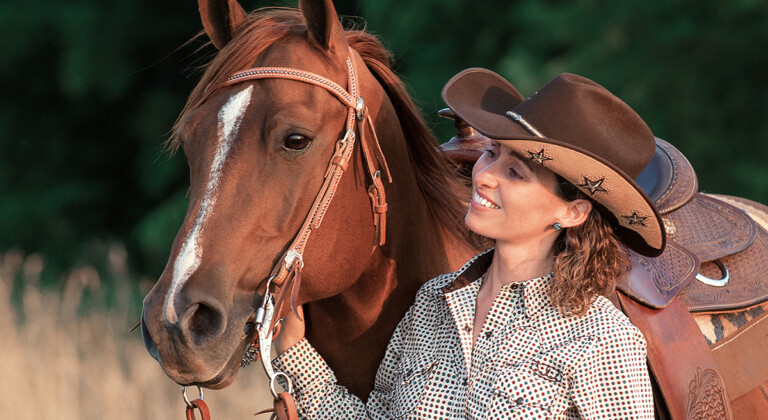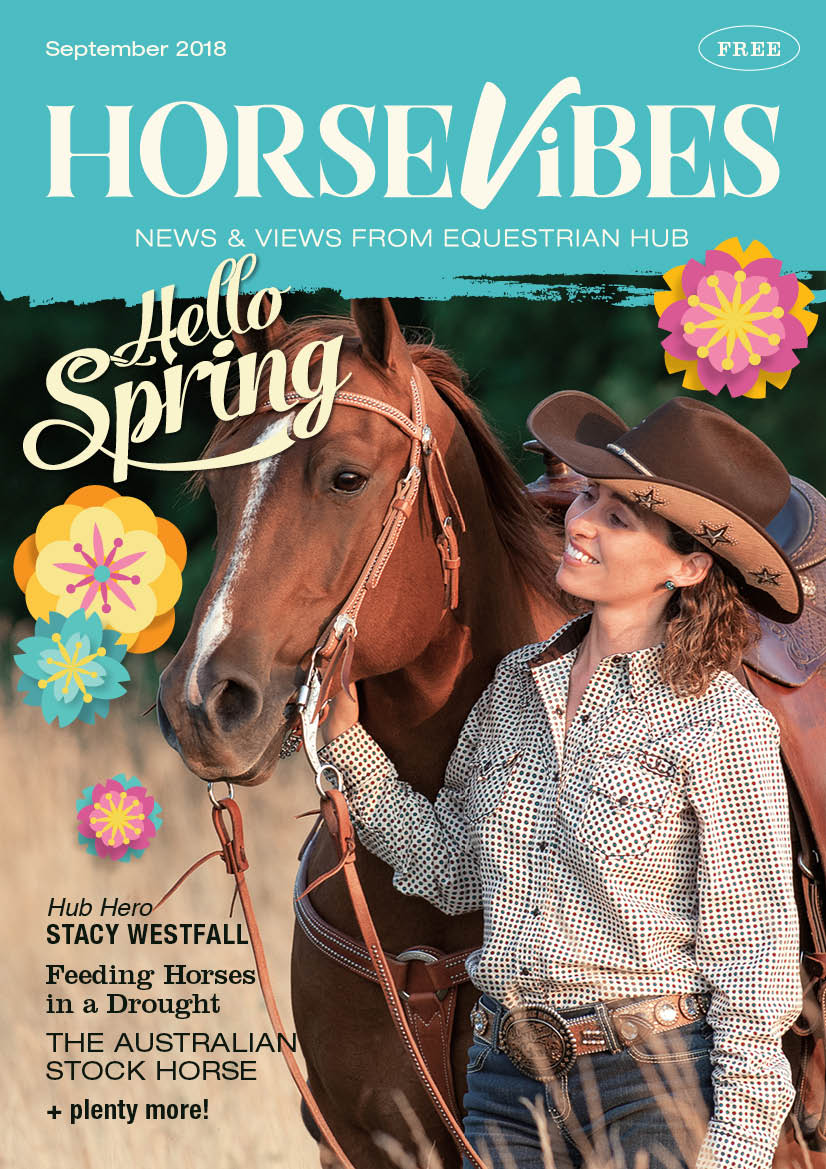Stacy Westfall is our Hub Hero this month. The extraordinary 2006 video of her winning the All American Quarter Horse Congress Freestyle Reining Competition, riding the beautiful black mare Roxy both bridleless and bareback went viral, and Stacy became an overnight sensation. And she’s back in Australia for Equitana 2018 later this year, writes Candida Baker.
Equitana visitors you’re in for a treat. This year Stacy Westfall, the first (and only woman) to win the Road to the Horse colt starting competition in the US, is coming back to Oz for her only overseas demonstration this year, where she ll be giving a horsemanship masterclass.
Stacy is a woman for firsts and an unusual one was undoubtedly being the first person to have Ellen de Generes ride her horse the famous Roxy, aka Whizards Baby Doll, without a bridle in front of a TV audience of millions.
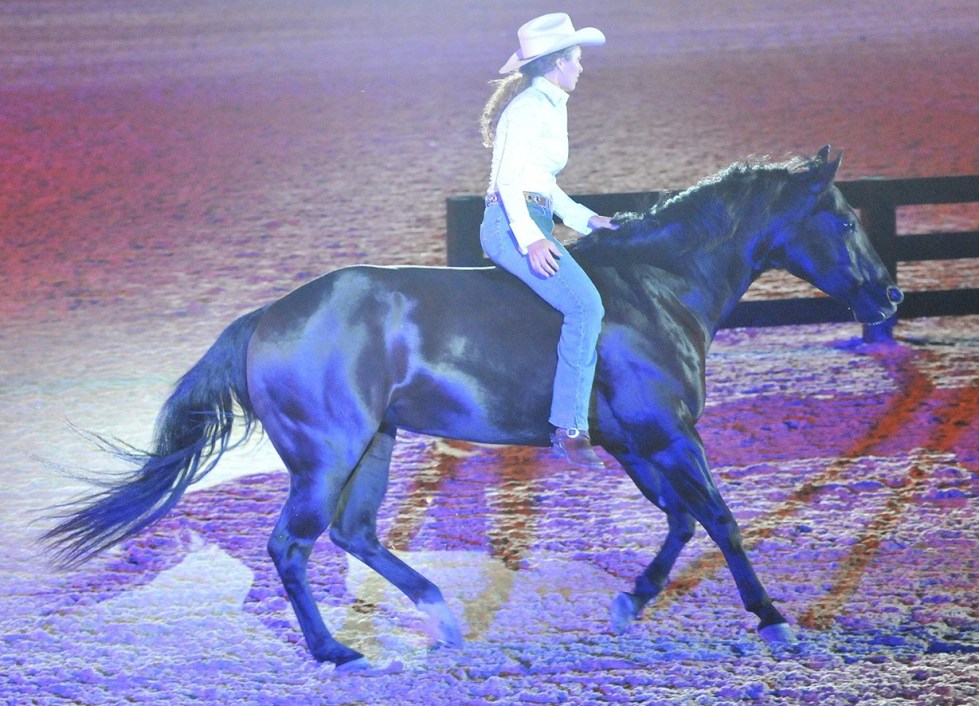
Stacy and her husband, Jesse, own and operate Westfall Horsemanship, in Ohio where they live with their three teenage sons when they’re not on the road which is most of the time. One of the most sought-after clinicians in the industry, she was inducted into the National Cowgirl Hall of Fame in 2012.
And it all started with one question – why?
Imagine you’re an 11-year-old girl out riding with your friend on a wintry day in Ohio. You’re in the driveway of your friend’s house, when somehow her horse backs itself right up into a snowdrift, and sits down. Stacy remembers the moment vividly. The horse kind of sat there, looking around as if to say, now this is weird , she says. Most kids would have laughed, and moved on, but not Westfall.
She wanted to see if she could persuade the horse to do on purpose what had happened by accident. Why, she says, did it sit? And could I get it to do it again? Well, it didn’t take long before the horse would back right up to the snowdrift and sit. And from there it wasn’t much of a stretch to train that horse to back up to anything, anywhere and sit down.
Fast forward some 32 years and Westfall has become famous around the world for her amazing ability to train, ride and compete horses without a saddle or bridle. And you don’t have to be a horse expert to know that riding a horse without a saddle or bridle is not your normal everyday kind of riding, or that riding a horse without a saddle and bridle at a gallop in a stadium full of people, under lights and winning America’s largest freestyle reining event, is, without a doubt, an extraordinary kind of riding.
Westfall’s high profile is, she says, in part testament to the power of technology, and was the result of her winning the 2006 NRHA ride saddle-less and bridle-less ride going viral on You tube. It was huge, she says. At the time, we had no idea what had happened we got so many hits on our website the whole thing went down, we just couldn’t handle the capacity.
Westfall attributes her success, not just with horses but also with teaching people to ride, to her mother’s insistence that they question everything. My mother was a teacher, she explains, and with all the animals around us she would always get me to question why an animal behaved in a certain way why do you think the dog did that? And I would try to come up with an answer.
Long before there was official riding for the disabled, or riding or horses as therapy, Tracy remembers her mother bringing Down Syndrome children and their parents over to ride, or to hang out with horses. As a teacher, her mother also worked visually and with positive reinforcement.
Growing up in Maine we didn’t have any professional teachers, so we just learned as we went along, she says. My mother would always tell me pretend you have a little birdie sitting on your hands she used a visual language to explain instructions which I think is something that helps everybody, particularly children, understand messages. If you say to someone don’t move your hand so fast, that is still negative and humans, and horses, simply don’t respond well to negative reinforcement. Imagining you have a small bird on your hands is a much more gentle, and yet stronger way to get your message across.
The road to success wasn’t smooth. It wasn’t quite – here’s this horse let’s just take its saddle and bridle off, she says. The first saddle-less and bridleless ride I did before I went to college was just a flat-out gallop that ended up in me falling off.
Stacy put her bridleless riding ideas to the side for a while, finished her college degree where she studied horsemanship, and her particular skill of reining, met her horse-riding NHRA coach husband, Jesse and started a family before the idea raised its head again.
Reining requires competitors to do specific routines including a required number of spins, circles, lead changes and sliding stops; freestyle reining has the same requirements but competitors can create their own routines, and they can also ride in costume if they want. The horses used for reining, quarter horses, are particularly powerful often stocky in comparison to thoroughbreds, but built for speed and strength.
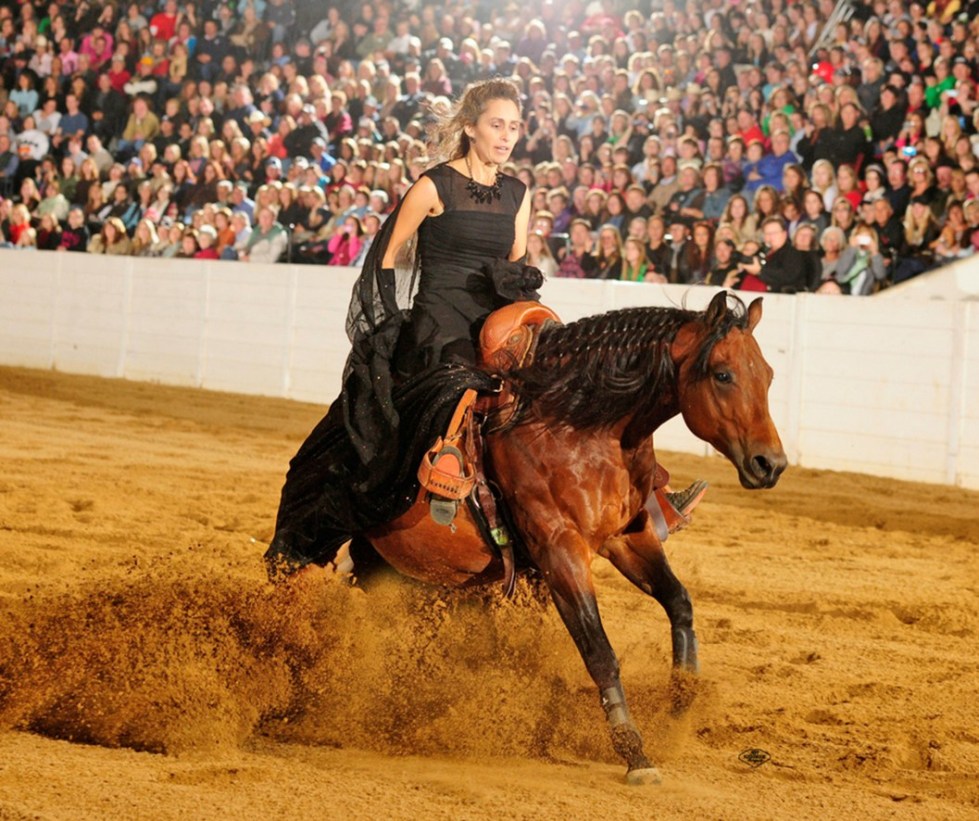
It was back in 2003 when Westfall was competing in a competition that she dropped a rein, but rather than stop the routine because of the fault, she leant down to pick it up. I was disqualified, she says, but it started me thinking about the idea of riding with no bridle again.
“What interested me was that the higher up the levels of reining a rider gets, the less visible the aids become, and the riding becomes more and more resistance-free. If I could translate those very subtle cues to a horse by way of just my legs, hands and weight, I thought I might be able to get somewhere.
One of the curious aspects of being in the spotlight for any sport, but particularly for a female in a male-dominated sport, or for anyone trying something new, experimental or unknown is that if you don’t win, you’re
perceived to be a failure.
The failure police were very much in evidence when Stacy competed in the Road to the Horse in which competitors have only a matter of hours, spaced over three days to start an unbroken horse, to ride it, and to compete it on the last day over obstacle courses. As the only woman to have ever been chosen to compete, all eyes were on Stacy, who decided that unlike the other competitors she was not going to rope her horse to bring it into her, she was going to use the round-yard and the pressure and release system, where the horse is sent gently but firmly away from you, until it asks to come and be friends so that it makes the choice.
Not only did she win, she bought the horse she had won with, and was astonished to find that she was the first person ever to do so. I just couldn’t imagine having worked that closely with a horse and then not buying it, she says. He was a good example of a horse she wouldn’t compete saddle-less or bridle-less. He was just not serious, she says, but he’s just not the kind of horse you could ride around with the reins tied to the pommel!
The road that she has chosen is ever easy. In Stacy’s first bridleless ride with Can-Can Lena, she left out one movement and was again disqualified. For Westfall it’s all about being competitive with herself, rather than with other people: I bring it back to me and the horse all the time, she says. She and Can-Can Lena won their next competition bridleless, and the crowd, loved it.
Just as with humans, there are no two horses alike every single horse as its own individual quirks and characteristics. Finding a horse with the right attitude isn’t simple.
They’re just not all suited to that sort of work, she says. It doesn’t mean that they aren’t good horses, but say you start with a hundred horses to look at, you sort through to find 60 that have potential, and then as you go along you keep refining the training. For this sort of work you need a horse that has the brain, and the physical ability, one that can be quiet and focuses on their work.
The level of work is intense
Westfall reckons 1000 hours go into teaching a horse to go bridle-less and saddle-less, and she works the horses she is training for an hour a day, five days a week. But it is within that work schedule that Westfall comes to understand exactly what makes her horse tick. For example, she describes her horse Can-Can Lena as like a: prim British nanny, whereas my next horse, Roxy, who was owned by a client of mine, Greg Gessner, was much more mischievous, but she still loved her work, which is the main thing you are looking for.
It was Roxy who endeared herself to millions of viewers on the Ellen de Generes show, not just by her quiet obedience with a complete stranger sitting on her, but by her calm demeanour when Stacy rode her into the TV studio, with no saddle and bridle, where she stayed quietly during the interview, bowing to the audience. One of the sad realities of life is that our beautiful equine friends are as fragile as they are fast and strong. Stacy and Greg Gessner lost Roxy in February 2012 at the age of 11, when she cast herself in her stall, injuring herself beyond repair.
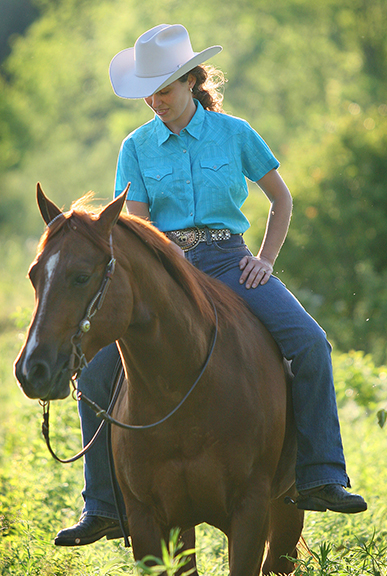
One of Stacy’s trademarks is that she believes all horses benefit from being on a loose rein. It’s the first step, she says to creating the trust that allows you ride first without reins, and second without the bridle.
This is another reason for Stacy’s success – her ability to give her horses and the riders she trains responsibility. There comes a time where you have to say to yourself, this horse, or this person is capable of making these decisions, and if I carry on insisting, then I’m lessening their ability to think for themselves.
Equitana Melbourne is on between November 15-18 at Melbourne Showgrounds where Stacy Westfall will be giving a specialist horsemanship clinic. Visit www.equitana.com.au
This article was taken from September’s HorseVibes Magazine.

